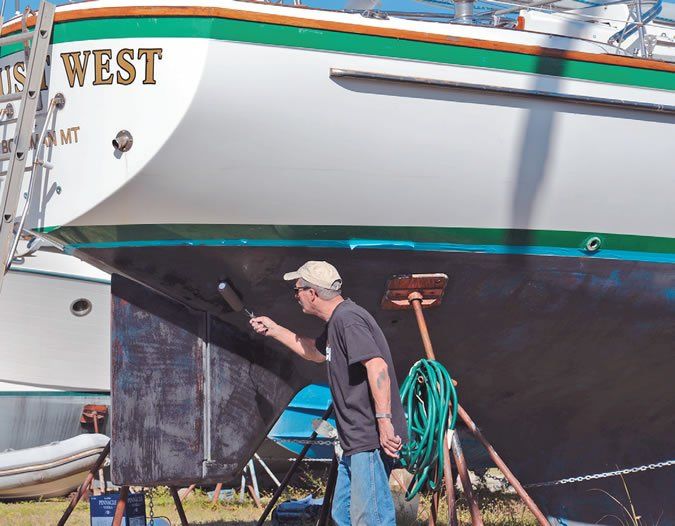Our past studies of freshwater bottom paints and regional bottom paints is another reminder that the most effective paint in our testing might not always be the best for your circumstances or location.
Unless you’re prepared for more prep work than a light sanding, the first step in selecting a bottom paint is finding one that’s compatible with what’s on your hull now. All of the manufacturers in our test will provide guidance on this, either over the phone or on the company website.
Generally, you can repaint a hard paint with either a hard or soft paint, while a soft ablative paint will need more sanding or a tie-coat primer when being coated with a hard paint. Bare fiberglass or metal will require a primer, and aluminum components like saildrives need a special copper-free paint that won’t induce potentially disastrous galvanic corrosion.
Before plunking down nearly $250 or more a gallon, consider where your priorities lie.
Simple application: With no unpleasant solvents, water-based paints are easy and safe to apply.
The environment: Driven by legislation regulating copper loading in sensitive waters, this is a fast-growing field. In recent tests the copper-free blends from Epaint have proven the most effective in marine environments. This is good news for owners of aluminum boats, which are incompatible with most copper-laced paints. Freshwater boats will be pleased with some of the less expensive paints featured in this months report.
No paint buildup: Over time, ablative paints wear away; hard paints generally form thick layer cakes.
Quick recoating: Hard paints can take a second coat sooner than ablatives, although some of the newer copolymer ablatives can be recoated after four hours or less. Thin-film Teflon paints for racing boats can dry in a matter of minutes.
Haulout schedules: Some paints (typically hard paints) lose their effectiveness if not launched within a certain time frame, or if the boat is hauled out and then relaunched without painting. Some paints you need to lightly sand or scuff to reactivate before relaunching.
Trailerability: Some ablative paints are designed to resist abrasion from trailering. Most hard paints will trailer well, but not all are meant to dry out.
Color: Pettit Vivid, Interlux Trilux, and Blue Water Kolor offer broad palette choices. Typically, the low-copper paints (Epaint being an exception) offer more color choices. If potency is what you’re after, some makers suggest black, although our panel studies are inconclusive regarding this. Some brands (such as Pettit) put a little more copper in some of their red paints.
Want to be a part of our bottom paint testing program? Fill out this quick survey at https://goo.gl/qTbu6p so we can share your experience with other sailors.









































When we moved our Pearson 303 from the Atlantic Coast to an Inland Lake, 34 years ago, we wondered what was the best antifouling paint to use in fresh water. We had been using Woolsey Neptune II copper based ablative paint in the Atlantic waters, re-applying it every 12 months or so. So we called Woolsey to ask them what paint to use before launching the boat in fresh water. They discussed tin based paint as the most cost-effective option, and then they asked me what I had been using. When told about the Neptune II, their comment was “you’ll never have to paint the bottom again.” I had some paint left over from the last application, so we threw that on the bottom, launched the boat, and we’ve never had to paint the bottom again. They were 100% correct, even after 34 years!